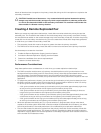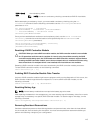
was created. Snapshot repository virtual disks cannot be selected as a source virtual disk or target virtual
disk in a virtual disk copy.
The virtual disk for which the point-in-time image is created is the source virtual disk and must be a
standard virtual disk in the storage array.
You can select snapshot virtual disks as the source virtual disk for a virtual disk copy. Selecting a snapshot
virtual disk is a good use of this feature, because it enables complete backups without significant impact
to the storage array I/O. However, some I/O processing resources are lost to the copy operation.
The Snapshot Virtual Disk feature can be used with the Virtual Disk Copy feature to back up data on the
same storage array and to restore the data on the snapshot virtual disk back to its original source virtual
disk.
Virtual Disk Copy
The Virtual Disk Copy premium feature copies data from one virtual disk (the source virtual disk) to
another virtual disk (the target virtual disk) within a single storage array. You can use this premium feature
to perform these functions:
• Copy data from disk groups that use smaller-capacity physical disks to disk groups that use larger-
capacity physical disks
• Back up data
• Restore snapshot virtual disk data to the base virtual disk.
You can use a primary virtual disk in a remote replication as a source virtual disk or a target virtual disk in
a virtual disk copy. You cannot use a secondary virtual disk as a source virtual disk or a target virtual disk.
NOTE: If you start a role reversal during a copy-in-progress, the copy fails and cannot be restarted.
Storage Partitioning
Storage partitioning enables hosts to share access to virtual disks in a storage array. You create a storage
partition when you define the following storage array assignments:
• A host
• A host group
• Virtual disk-to-logical unit number (LUN) mapping
The virtual disk-to-LUN mapping enables you to define which host group or host has access to a
particular virtual disk in the storage array.
After you create a virtual disk copy, the target virtual disk automatically becomes read‑only to hosts to
ensure that the data is preserved. Hosts that have been mapped to a target virtual disk do not have write
access to the virtual disk, and any attempt to write to the read-only target virtual disk results in a host I/O
error.
If you want hosts to have write access to the data on the target virtual disk, use the set
virtualDiskCopy
command to disable the read-only attribute for the target virtual disk.
109


















